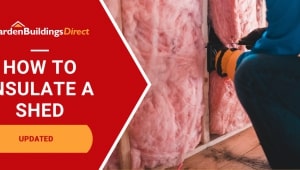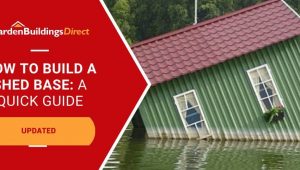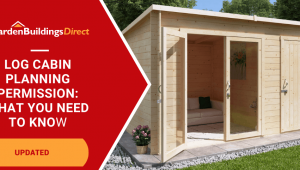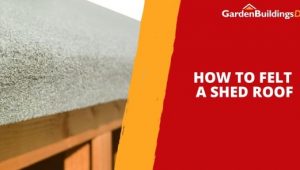Jump to:
Shed Damp Proofing Methods
Keep your shed dry with these simple damp‑proofing tricks:
- Seal the gaps around doors, windows, and the base with silicone caulk or expanding foam.
- Install a gutter to get rainwater away from the shed foundation to prevent pooling.
- Use a vapour membrane between the shed framing to block moisture from getting inside.
- Invest in a hygrometer and a dehumidifier to monitor and control humidity inside.
To damp proof a shed means stopping moisture from damaging the building’s lifespan. While this may seem daunting, it can be manageable with the proper guidance. Here, we explore methods to get rid of dampness, addressing issues like mould and mildew.
How Do I Prevent Mould in My Wooden Shed?
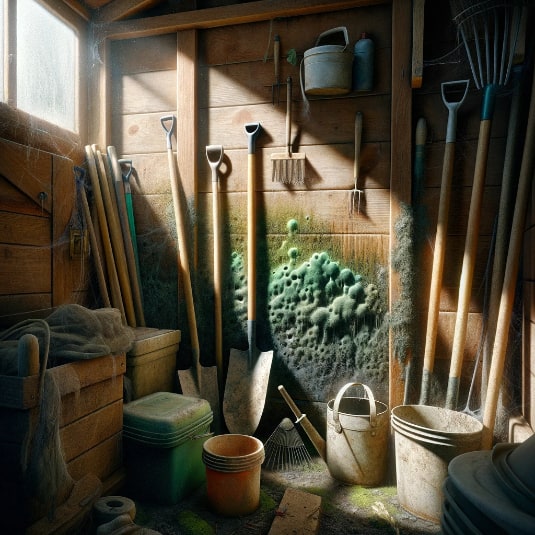
The secret is simple: air it out. With no fresh air flow, stagnant air just sits in your shed. This air holds moisture and can condense on walls and windows. Boom—now you have mould and mildew in your storage building. Practice shed ventilation to allow fresh air circulation in the interior. Simply open the windows or install vents, skylights, or whirligigs on the shed’s roof.
It’s also smart to avoid storing damp items like fabric and wooden furniture. Clothing and linens are prone to absorbing moisture. They can become mouldy and musty and develop stains and unpleasant odours. Wood is particularly sensitive to fluctuations in humidity, too. It can be susceptible to swelling, warping, and even rotting. Moisture can also attract pests like termites, further damaging the furniture.
Interior treatment shouldn’t be necessary if you’ve invested in a pressure treated shed. Otherwise, consider these alternatives:
- Gap sealing: This is one of the effective ways to prevent moisture intrusion. Use a silicone caulk gun or expanding foam to seal any openings around windows, doors, or the base. Draught excluders block air entry, while expanding foam fills window gaps.
- Gutter installation: This manages water run-off. It stops moisture from seeping through the roof and prevents water pooling.
- Vapour membrane: Install a vapour membrane between the shed’s framing. Read our guide on shed insulation for more information.
- Hygrometer and dehumidifier: Keep an eye on humidity levels with these two equipment. The hygrometer tells you how damp the air is, and the dehumidifier helps bring it down so your shed stays dry.
How Do I Treat Mould Effectively?
Treating mould in your shed is crucial to maintaining a safe, healthy environment. Even if mould has already appeared, it’s never too late to take action. Here are simple steps to effectively tackle the growth and prevent its recurrence.
1. Clear out and inspect
Take everything out of your shed and check your furniture and tools for damp or mould. This way, you can spot any hidden wet spots.
2. Check for leaks
Go over the shed base, roof, and walls to spot any leaks, damp patches, or water stains. Even small drips can lead to mould if left unchecked. Fix any leaks straight away.
3. Bleach solution treatment
Mix up a diluted bleach solution, about 1 part bleach to 4 to 10 parts water, and pour it into a spray bottle. Wear gloves and old clothes for protection. Open the shed doors and windows for ventilation. Spray the affected areas and use a sponge to scrub away mould and spores.
4. Allow for ventilation
After treating the mould, leave your shed to air out for a full day if possible. Proper ventilation helps dry out the treated areas and prevent moisture buildup.
5. Apply shed treatment
After cleaning, coat the shed exterior with a shed treatment and pesticide. It keeps the wood protected from moisture and stops pests from moving in. Follow the product instructions for best results.
6. Respray vinegar
After the treatment, respray affected areas with a diluted vinegar solution. Vinegar works as a natural fungicide to stop mould from coming back. If you don’t like the smell, you can add a bit of fragrance to the spray.
7. Optional measures
Consider leaving open containers of baking soda or using a dehumidifier in your shed. Baking soda soaks up moisture and deals with any musty smells. A dehumidifier can help too, keeping the air dry so mould doesn’t have a chance to start again.
Round-up
Mould and damp don’t stand a chance once you keep an eye on leaks, airflow, and moisture. Stick to the steps above, and your shed will stay dry and ready for whatever you store in it.
When it’s time for a new investment, check out our available range below:
[Shop Sheds Button]
FAQ
What if my shed has already started to rot?
Small patches of rot can be treated with wood hardeners and filler. But if more than 10% of the shed is affected or the floor is compromised, replacement is safer. Always remove rotten timber and treat the surrounding wood to prevent further damage.
Can I prevent mould without a dehumidifier?
Yes, as long as there’s good ventilation inside, the gaps are sealed, and you use a vapour barrier. These methods can reduce moisture even without using a dehumidifier.
How often should I check my shed for damp?
Inspect your shed at least twice a year, ideally in early spring and early autumn. Look for leaks, mould, and any soft or warped wood. Early detection helps prevent long-term damage.
Are pressure-treated sheds completely safe from damp?
They’re much more resistant but not completely immune. Ventilation, guttering, and routine checks are still essential.
If you have any further questions, contact us and don’t hesitate to give us a call at 01909 768840.
